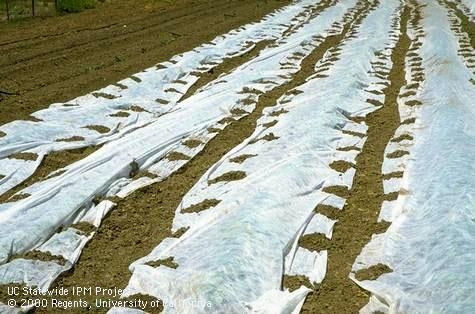- Author: Kim McCue
- Editor: Noni Todd
The Artful Use of Floating Row Covers
By Kim McCue
On the Central Coast, the average last frost is as early as February 15 in San Luis Obispo, or as late as April 7 in Paso Robles. Therefore, some of us have already planted our vegetable gardens, and some of us are still chomping at the bit to get started. Either way, the threat of a late frost or damaging pests looms. However, these variables can be mitigated with floating row covers. Providing a protective cover will give your freshly planted vegetable garden a better chance of surviving its early days.
When used to protect new seeds or seedlings, floating row covers act as a barrier to birds and other animals that would love to feast on your seeds and tender plants. Bury the edges of the cover in the soil to exclude snails and insect pests. Do, however, check your plants regularly because any pests that do find their way into the cover will thrive in this comfortable environment. These row covers serve the same purpose as the large white covers you see along highway 101 that house raspberries and blackberries: they increase the air temperature surrounding the plant. In your backyard, this will allow you to sow or plant earlier in the season by a couple of weeks. For insect pollinated crops, covers must be removed when blossoms appear to allow for pollination to occur.
Floating row covers protect against frost in early spring, and can be used to extend warm weather crops by protecting against frost in the fall. Many a tomato has been saved in October when a savvy gardener has gently covered it prior to an early frost.
Floating row covers woven from polyethylene, polyester, or polypropylene are one of the most useful tools for protecting plants from cold temperatures and certain pests. They are extremely lightweight and can be laid directly over seeded beds or plants, or they can be propped up on stakes or laid over hoop frames. Serving as miniature greenhouses, they transmit 80 to 95% of the sunlight that strikes them, and allow both water and air to pass through. The material is sold in rolls and packaged sheets at your local nursery, farm supply or garden center, and is reusable for several years if handled carefully to prevent tears.




